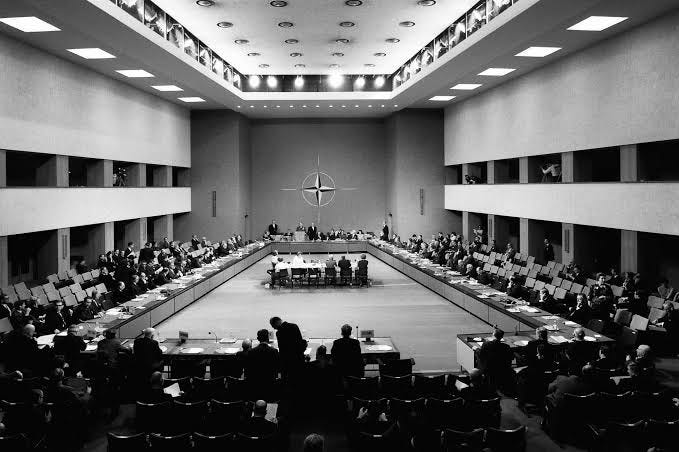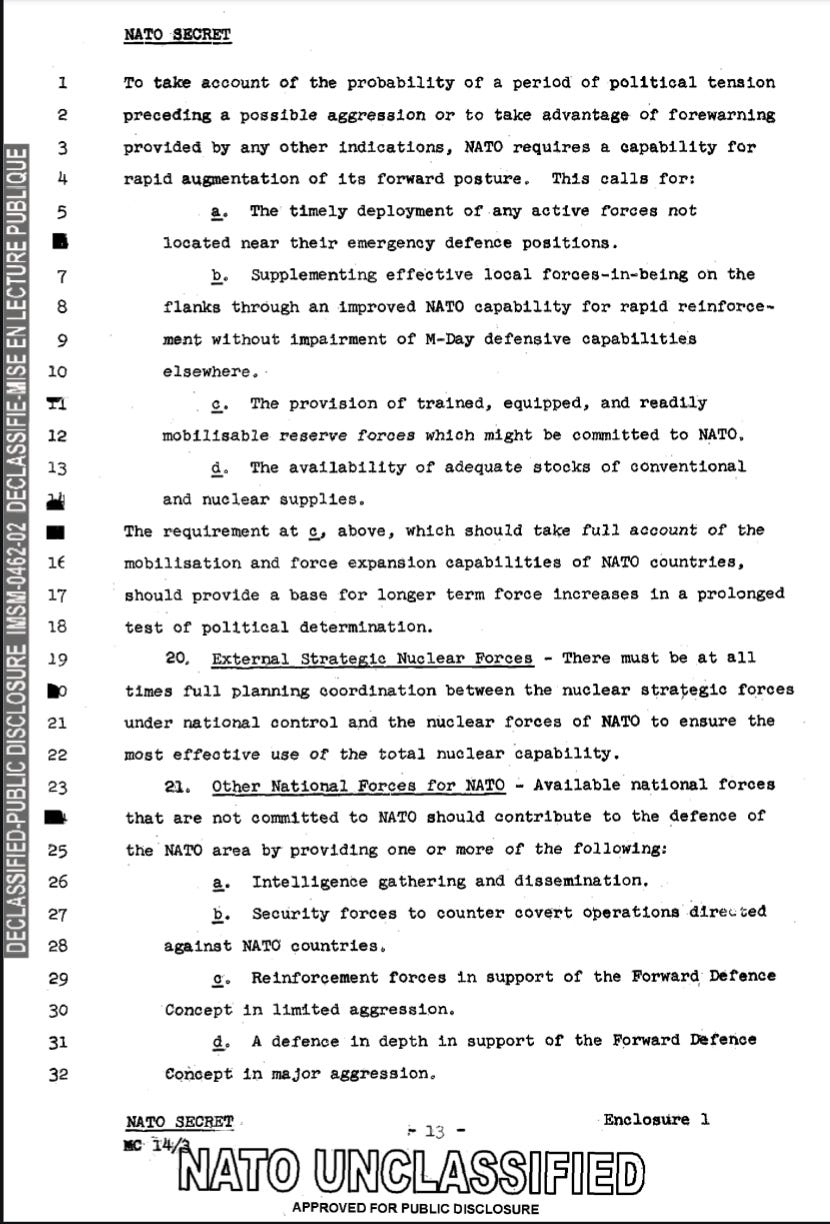Why We Extend Deterrence
It was never about charity. We extend deterrence to benefit America and Americans.

The prospects of Donald Trump's second term created familiar concerns among allies regarding U.S. commitments. However, few expected that fundamental U.S. security guarantees would be open for debate. The origins of U.S. extended deterrence policy--how the U.S. “nuclear umbrella" deters aggressors, earns allies' trust and cooperation, and prevents the further spread of nuclear weapons--sprang from the horrifying destruction of World War Two. After tens of millions dead and a massive destruction of civilian infrastructure, the United States set out to advance rules-based systems of government, empowered by security commitments and considerable military strength, to avoid the onset of global war ever again.
Alliances are a great deal for America. The United States never extended its nuclear arsenal to protect formal allies or alliances such as NATO--which was always and remains a “nuclear alliance"--out of altruism. It did so to advance U.S. interests:
to provide the United States essentially free geographic access and advantages, such as markets, bases, sea lanes of communication or “SLOC," and fuel, to compete with the Soviet Union;
to generate a force multiplier which provided the United States with partner capabilities and which, politically, presented the U.S.S.R. with a united deterrent front;
to keep the economies and political systems of Western Europe and Asia free; and crucially,
to prevent allies from seeking their own nuclear weapons--a goal in itself but which also made Washington the primary decision center in crises that may involve the employment of, and/or escalation with, nuclear weapons.
These core U.S. vital interests remain today with NATO and Indo-Pacific allies. We jettison them at our own peril.
Some History
After World War Two, the prospects for a long-term peace dividend faded quickly, as the geopolitical environment shifted quickly from allied celebrations to the bitter U.S.-Soviet strategic competition that would dominate the Cold War. As one of the two super powers, U.S. leaders sought to buttress an emerging international system by protecting friends from the aggressive, nationalist-driven campaigns of conquest of the 1900s, should they ever materialize again.
The United States signed the North Atlantic Treaty on April 4, 1949, agreeing with European Allies:
“that an armed attack against one or more of them in Europe or North America shall be considered an attack against them all; and each of them will assist the attacked by taking forthwith, individually and in concert with the other Parties, such action as it deems necessary, including the use of armed force.”Versions of this commitment were concluded in numerous bilateral and multilateral treaties with other allies in Asia and the Western Hemisphere. These guarantees ranged from those which may require U.S. military action on an ally's behalf--similar to the NATO commitment--to more generic promises of military assistance or consultations in event of a war.
The security commitments did not constitute American charity, and American officals never berated recipients of U.S. aid for a public “thank you.” Alongside a massive influex of foreign aid through the Marshall Plan, the U.S. willingness to support European stability and security created unity among democracies, opportunity for Europe to focus more on rebuilding and less on the Red Army or possibility that Communism would take hold in their own countries, and opened an incredible market for U.S. goods. It also provided the United States with tremendous amounts of real estate to forward base military forces for American as well as European defense. The stimulant that European reconstrution provided to the U.S. economy, and the creation of a massive long-term marketplace friendly to U.S. producers, led to historic economic growth in the United States as American soldiers returned home to start new lives.
However, the initial post-World War Two approach could only last so long, and U.S. military strategy had to shift to ensure the new security commitments remained credible. The U.S. nuclear monopoly of 1945 quickly faded with the U.S.S.R's “Joe-1” test in 1949, creating concerns among U.S. allies on whether Washington would use the superweapon to protect them if the Soviets had the bomb as well. Early U.S. nuclear strategy was designed to be economical: upon the onset of any NATO-Soviet conflict, long-range bombers based in the United States would rapidly deploy to destroy Soviet population centers with atomic weapons. The approach was designed to allow President Eisenhower to reduce expensive U.S. troop commitments overseas, and rebuild the U.S. economy after decades of war.
But the original “massive retaliation" approach became implausible once the U.S.S.R. achieved the ability to strike the U.S. homeland with a nuclear weapon, especially with the arrival of intercontinental-range ballistic missiles. The launch of Sputnik-1 in 1957, remembered for the impact it had on the burgeoning “space race,” also highlighted the possibility that the United States and Soviet Union could fight a devestating nuclear war with on another irrespective of what was happening on the European continent. The new dynamic created incentives for the two sides to maintain a stable balance of terror with regard to one another, one-on-one.
A by-product of the new dynamic was the potential for Moscow to “decouple" the United States from its allies--that is, the possibility that America might abandon European allies in order to ensure the Soviet Union saw no legitimate reason to threaten nuclear strikes against the U.S. homeland during a crisis in Europe, therefore allowing the Warsaw Pact to attack NATO with massive conventional forces with impunity. Many allies felt a massive nuclear retaliation in response to a conventional Soviet attack was irrational; expecting the United States to commit national suicide in response to a conflict far away from home couldn't possibly make sense to an American president. The regional deterrence gap created by Soviet advancements and the U.S. massive retaliation strategy demanded a new approach.
In the 1960s, the United States moved toward a “flexible response" strategy with its allies, seeking to establish mutual deterrence with its Cold War adversary in a hypothetical conventional or nuclear conflict, as well as a regional or strategic conflict. The savings of the “massive retaliation" approach were short-lived; the United States and its allies began spending more to ensure local and regional defense capabilities were sufficient to convince the Soviet Union that it could not achieve its aims in a European war. It was also designed to assure allies that the United States could thwart a Soviet attack without having to risk nuclear war, but also that the United States would possess credible regional and strategic nuclear capabilities to limit damage to both allies and the United States should conventional deterrence fail. Instead of impossibly trying to convince allies that we would trade Boston for Berlin, we tried to convince them that we could save Berlin without losing Boston--a strategy that essentially persists today.
It is not coincidence that this strategy emerged when West Germany made credible noises about pursuing its own nuclear weapons in conversation with other European allies. Indeed, the United States went to great lengths--including by establishing nuclear sharing arrangements with Bonn in 1958--to prevent the emergence of an independent nuclear decision center on Continental Europe (excepting France's development of a nuclear force independent from the NATO structure). U.S. and allied planners also worked closely together to ensure that military, diplomatic and intelligence officals created a seamless avenue for information sharing among governments involved, so joint military exercises demonstrated a credible, powerful defensive capability where all countries played a part. The calibrated and comprehensive approach avoided an over-reliance on strategic nuclear weapons deemed less-than-credible for the initial stages of a defense of Europe while also ensuring NATO was prepared for conflict at every level of escalation.

The additional spending required for the new approach was deemed affordable compared to fighting a nuclear war. Without credible forward-deployed conventional and other military forces, there was an increased likelihood that a regional war could begin. Whether the United States chose to come to the aid of its allies or not, the resulting global economic disruption would certainly impact the lives of everyday Americans.
Fast Forward to the Present
Components of this strategy, and dilemma, persist today. The United States and its allies in NATO and the Indo-Pacific maintain extended deterrence consultations, ensuring the strategic partnerships are fit for the current security environment. The nuclear-focused conversations of the Cold War expanded as deep precision strike, missile defense, space security, risk reduction, and cyber and other emerging technologies are integrated into military policy and planning. The United States, to this date, upgrades the software of extended deterrence--the diplomacy and information sharing that keeps treaty allies on the same page--to keep pace with current threats and ensure allies contribute their fair share to deterring new security challenges. For example, Indo-Pacific allies are discussing the roles they can plan in a potential contingency involving China, not just requesting U.S. support in deterring North Korea's local provocations. NATO allies began talking about additional roles they can take on to defend Europe from Russian aggression if the United States is simultaneously dealing with a crisis in the Indo-Pacific. The same allies regularly commit to reinforcing their own defense capabilities in furtherance of U.S. and alliance interests. Extended deterrence is not a one way street: we get bases and material support in furtherance of our own security interests.

As was the case in the Cold War, the possibility of U.S. abandonment is generating real consideration by allies for independent nuclear arsenals. Indeed, Germany's incoming Chancellor, Friedrich Merz, suggested his country may need to break with decades of tradition and consider a Europe-only nuclear arsenal with the United Kingdom and France. The approach is not new. French President Emmanuel Macron raised the prospects of a “Euro-deterrent" during Trump's first term as part of a call for greater strategic autonomy for Europe, out of concerns the United States may untether itself from the Transatlantic Alliance if not become an outright confrontational actor. He has again signaled his readiness to advance these conversations after Ukrainian President Volodymyr Zelenskyy's recent visit to the Oval Office. European countries are moving rapidly to consider how to address security needs without a U.S. nuclear backstop; the public support for non-U.S. nuclear deterrence may be growing. It will not be easy for Europe to replace the American nuclear deterrent, particularly the strategic forces which are crucial to deterring possible Russian escalation in a war. The mere effort to advance a substantial Euro-deterrent could trigger crises and conflicts that could reverberate across the globe--Russia may not sit back quietly as Ukraine, Poland, or Germany develop nucelar alternatives to the United States.
The consequences of abandoning our extended deterrence commitments could be dire, and not obvious to those who believe the United States can safely retreat home, protected by two large oceans and unfettered by foreign commitments.
First, it is difficult to imagine the United States faces a welcome economic market in Europe if the security basis for the relationship disappears. One does not need to look further than the United Kingdom's Brexit experience to contemplate market impacts to the United States. As one example, consider Europe's efforts to strenghten deterrence capabilities. European conventional rearmament may be closed to the United States in the future, as European defense firms look to buttress domestic ingenuity and supply chains out of fear the United States may continue to withdraw and withhold defense technology and assistance. The new Administration would be mistaken in closing the door to support a European defense transformation.
Instead, the United States should advance the defense trade streamlining efforts began by President Biden, for the explicit purpose of supporting allies who were willing to put their economies at risk by joining U.S.-led export controls and sanctions against Russia. The same allies proved willing to contribute a greater share to the deterrence burden sharing equation, and the U.S. government should continue to make access to technological crucial for conventional deterrence easier for our closest allies, following up on President Biden's efforts to loosen red tape on decades-old policies governing the sharing of missile and UAV technologies, critical to contemporary conflicts. The benefits to the U.S. economy are clear, as is the ability for President Trump to further his administration's goal of getting allies to contribute more to their own defense. The United States should recommit to defense cooperation with allies, and if Washington requests additional allied spending, U.S. officials should provide specific guidance to allies on where new resources should go to fulfill a comprehensive extended deterrence strategy.
Second, it is unlikely that the spread of nuclear weapons can be isolated to European allies. South Korea sees a stronger case for proliferation in the face of an advancing North Korean nuclear arsenal. The Biden Administration, worried about security dynamics on the Korean Peninsula, worked closely with South Korean allies to upgrade the extended deterrence relationship. In the Washington Declaration, the U.S.-ROK alliance committed to enhanced dialogues, exercises, and planning integration while Seoul re-committed to its status as a non-nuclear weapons state under the Nuclear Nonproliferation Treaty.
Partners elsewhere could similarly lose faith in U.S. defense guarantees. The Administration's permission for others to develop nuclear weapons could go beyond legitimizing North Korea's arsenal; it could also demonstrate U.S. policy makers will not fight to limit Iran's nuclear program, and therefore will accept Saudi Arabia, UAE, or others who may seek their own nuclear hedging strategy. Of course, if U.S. friends go down this path, one can imagine non-aligned countries or adversaries may follow. The mere pursuit of nuclear weapons by these states may be a violent process-- China and Noth Korea may not sit idly by as South Korea, Japan, or Taiwan seek nuclear weapons. Core U.S. interests would undoubtedly be affected if Indo-Pacific proliferation sparked a war in East Asia as motivated actors try to kill prospective proliferators while they tried.
Third, multiple nuclear decision-making centers in the world will lead to less global stability. Regional actors, including those not seeking to choose a side among the United States, Russia, or China, may bring nuclear weapons into their own localized crises. The United States, in the process of removing itself from foreign entanglements, would have little ability to prevent smaller countries from using nuclear weapons to settle local grievances. Consider the experience of the Syrian Civil War, where despite initial international condemnation and action, Bashir al-Assad continued to use chemical weapons against his own population for nearly a decade with near impunity, once he found a gray area balancing the operational utility of chemical use against the threshold for strong international action.
Any of these conflicts with the potential for nuclear employment still have the potential to drag even a retreated America back in, as our vital economic interests--tied to global stability--come under greater risk. Promoting a world with many countries with nuclear weapons, with individual rather than shared or global priorities, and each with the ability to start a war that the United States may have to finish, is detrimental to U.S. security. Instead, the United States should continue to prioritize extended deterrence, one of our most effective nonproliferation tools, as every Cold War president has done. Even President Richard Nixon, whose detente approach, threat prioritization, and unpredictability Trump and his advisors seem to model, sought to advance this cause. Extended nuclear deterrence--which is fundamentally what NATO and our Indo-Pacific alliance architecture rests upon--is not just a good deal for the United States, it is a historically amazing deal for U.S. vital interests, and one that we are unlikely to recreate if it disintegrates.
Conclusion
Trump's desire for allies to take on a greater share of resourcing shared defense commitments is not surprising, nor is it new or original. The Administration's rapid defenstration of the value propositions of alliances, and pivot to embracing the position of nationalist adversaries has still come as a shock to the world order--even though Trump and Vance openly telegraphed this approach during the campaign. However, U.S. officials, underneath the uneasy politics of the new approach, should establish as a priority continuing the U.S.-engineered tradition of extended deterrence policy rather than abandoning it. An American invention, non-contiguous extended deterrence--protecting allies across two oceans with a mix of robust regional and strategic nuclear and conventional capabilities--has helped secure a stable world order since 1945. Ignoring this history will let the jungle of unconstrained, bellicose nationalist international politics rise once again. It is hard to see how the American people benefit from such an environment, and U.S. policies should serve as a break on any movement toward that world, not an accelerant.




